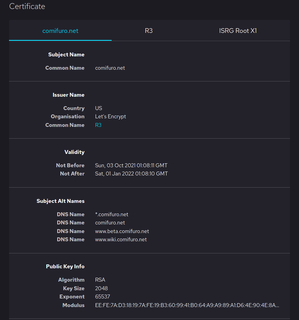
Hypertext Transfer Protocol Secure (HTTPS) is an extension of the Hypertext Transfer Protocol (HTTP). It is used for secure communication over a computer network, and is widely used on the Internet. In HTTPS, the communication protocol is encrypted using Transport Layer Security (TLS) or, formerly, Secure Sockets Layer (SSL). The protocol is therefore also referred to as HTTP over TLS, or HTTP over SSL.
A network switch is networking hardware that connects devices on a computer network by using packet switching to receive and forward data to the destination device.

An email client, email reader or, more formally, message user agent (MUA) or mail user agent is a computer program used to access and manage a user's email.

In computer networking, a proxy server is a server application that acts as an intermediary between a client requesting a resource and the server providing that resource.
In cryptography and computer security, a man-in-the-middle, monster-in-the-middle, machine-in-the-middle, monkey-in-the-middle, meddler-in-the-middle (MITM) or person-in-the-middle (PITM) attack is a cyberattack where the attacker secretly relays and possibly alters the communications between two parties who believe that they are directly communicating with each other, as the attacker has inserted themselves between the two parties. One example of a MITM attack is active eavesdropping, in which the attacker makes independent connections with the victims and relays messages between them to make them believe they are talking directly to each other over a private connection, when in fact the entire conversation is controlled by the attacker. The attacker must be able to intercept all relevant messages passing between the two victims and inject new ones. This is straightforward in many circumstances; for example, an attacker within the reception range of an unencrypted Wi-Fi access point could insert themselves as a man-in-the-middle. As it aims to circumvent mutual authentication, a MITM attack can succeed only when the attacker impersonates each endpoint sufficiently well to satisfy their expectations. Most cryptographic protocols include some form of endpoint authentication specifically to prevent MITM attacks. For example, TLS can authenticate one or both parties using a mutually trusted certificate authority.
A virtual private network (VPN) extends a private network across a public network and enables users to send and receive data across shared or public networks as if their computing devices were directly connected to the private network. The benefits of a VPN include increases in functionality, security, and management of the private network. It provides access to resources that are inaccessible on the public network and is typically used for remote workers. Encryption is common, although not an inherent part of a VPN connection.
Transport Layer Security (TLS) is a cryptographic protocol designed to provide communications security over a computer network. The protocol is widely used in applications such as email, instant messaging, and voice over IP, but its use in securing HTTPS remains the most publicly visible.

In cryptography, a public key certificate, also known as a digital certificate or identity certificate, is an electronic document used to prove the validity of a public key. The certificate includes information about the key, information about the identity of its owner, and the digital signature of an entity that has verified the certificate's contents. If the signature is valid, and the software examining the certificate trusts the issuer, then it can use that key to communicate securely with the certificate's subject. In email encryption, code signing, and e-signature systems, a certificate's subject is typically a person or organization. However, in Transport Layer Security (TLS) a certificate's subject is typically a computer or other device, though TLS certificates may identify organizations or individuals in addition to their core role in identifying devices. TLS, sometimes called by its older name Secure Sockets Layer (SSL), is notable for being a part of HTTPS, a protocol for securely browsing the web.
climm is a free CLI-based instant messaging client that runs on a wide variety of platforms, including AmigaOS, BeOS, Windows, OS X, NetBSD/OpenBSD/FreeBSD, Linux, Solaris, HP-UX, and AIX.
Deep packet inspection (DPI) is a type of data processing that inspects in detail the data being sent over a computer network, and may take actions such as alerting, blocking, re-routing, or logging it accordingly. Deep packet inspection is often used to baseline application behavior, analyze network usage, troubleshoot network performance, ensure that data is in the correct format, check for malicious code, eavesdropping, and internet censorship, among other purposes. There are multiple headers for IP packets; network equipment only needs to use the first of these for normal operation, but use of the second header is normally considered to be shallow packet inspection despite this definition.
OpenVPN is a virtual private network (VPN) system that implements techniques to create secure point-to-point or site-to-site connections in routed or bridged configurations and remote access facilities. It implements both client and server applications.
SAP NetWeaver Application Server or SAP Web Application Server is a component of SAP NetWeaver which works as a web application server for SAP products. All ABAP application servers including the message server represent the application layer of the multitier architecture of an ABAP-based SAP system. These application servers execute ABAP applications and communicate with the presentation components, the database, and also with each other, using the message server.

A computer network is a set of computers sharing resources located on or provided by network nodes. The computers use common communication protocols over digital interconnections to communicate with each other. These interconnections are made up of telecommunication network technologies, based on physically wired, optical, and wireless radio-frequency methods that may be arranged in a variety of network topologies.

Network Security Services (NSS) is a collection of cryptographic computer libraries designed to support cross-platform development of security-enabled client and server applications with optional support for hardware TLS/SSL acceleration on the server side and hardware smart cards on the client side. NSS provides a complete open-source implementation of cryptographic libraries supporting Transport Layer Security (TLS) / Secure Sockets Layer (SSL) and S/MIME. NSS releases prior to version 3.14 are tri-licensed under the Mozilla Public License 1.1, the GNU General Public License, and the GNU Lesser General Public License. Since release 3.14, NSS releases are licensed under GPL-compatible Mozilla Public License 2.0.
Server Name Indication (SNI) is an extension to the Transport Layer Security (TLS) computer networking protocol by which a client indicates which hostname it is attempting to connect to at the start of the handshaking process. This allows a server to present one of multiple possible certificates on the same IP address and TCP port number and hence allows multiple secure (HTTPS) websites to be served by the same IP address without requiring all those sites to use the same certificate. It is the conceptual equivalent to HTTP/1.1 name-based virtual hosting, but for HTTPS. This also allows a proxy to forward client traffic to the right server during TLS/SSL handshake. The desired hostname is not encrypted in the original SNI extension, so an eavesdropper can see which site is being requested.

Network forensics is a sub-branch of digital forensics relating to the monitoring and analysis of computer network traffic for the purposes of information gathering, legal evidence, or intrusion detection. Unlike other areas of digital forensics, network investigations deal with volatile and dynamic information. Network traffic is transmitted and then lost, so network forensics is often a pro-active investigation.
A TLS termination proxy is a proxy server that acts as an intermediary point between client and server applications, and is used to terminate and/or establish TLS tunnels by decrypting and/or encrypting communications. This is different to TLS pass-through proxies that forward encrypted (D)TLS traffic between clients and servers without terminating the tunnel.
OpenConnect is an open-source software application for connecting to virtual private networks (VPN), which implement secure point-to-point connections.

Packet Sender is an open source utility to allow sending and receiving TCP and UDP packets. It also supports TCP connections using SSL, intense traffic generation, HTTP(S) GET/POST requests, and panel generation. It is available for Windows, Mac, and Linux. It is licensed GNU General Public License v2 and is free software. Packet Sender's web site says "It's designed to be very easy to use while still providing enough features for power users to do what they need.".
A virtual private network (VPN) service provides a proxy server to users to bypass Internet censorship such as geoblocking or users who want to protect their communications against data profiling or MitM attacks on hostile networks.







